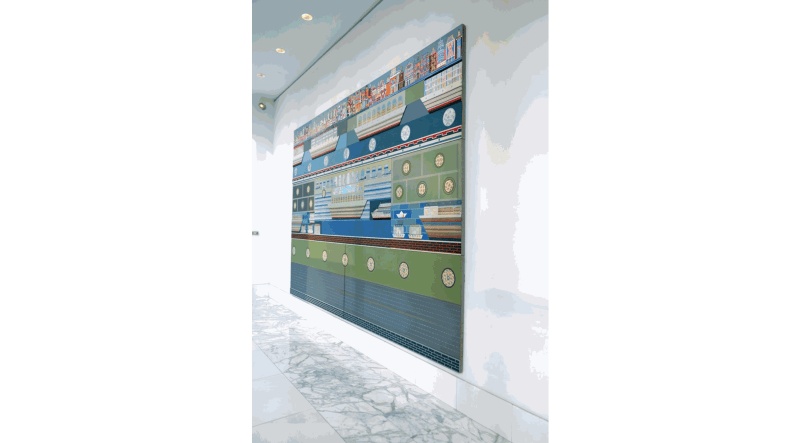532 GALLERY IS PLEASED TO PRESENT GEOGRAPHICAL MIND IN THE ARCHITECTURE OF LANDSCAPE, AN EXHIBITION OF RECENT WORKS BY CARLOS RODRÍGUEZ CÁRDENAS. IN HIS NATIVE CUBA DURING THE 1980S, CARLOS RODRÍGUEZ CÁRDENAS DEVELOPED AN INFLUENTIAL STYLE OF PAINTING THAT DEPLOYED IRONY, SLY HUMOR, AND A SHREWD PARODY OF HIGH-MODERNIST SOPHISTICATION TO MOCK THE CONCEITS OF OFFICIAL STATE-SPONSORED IMAGERY AND UTOPIAN SLOGANEERING. IN GEOGRAPHICAL MIND IN THE ARCHITECTURE OF LANDSCAPE CÁRDENAS TURNS A DISCERNING EYE TOWARD THE UNITED STATES, DELIVERING A BODY OF WORK THAT SEEMS AT FIRST GLANCE LIKE A LOVE LETTER TO THE AMERICAN LANDSCAPE AND TO THE MODERN CITY—NEW YORK BEING HIS ADOPTED HOME OF MANY YEARS NOW—YET GRADUALLY REVEALS AN UNDERCURRENT OF WARINESS AND DISQUIET ABOUT OUR NATIONAL MYTHS AND PRETENSIONS. ALONGSIDE THIS IS AN EXTENDED MEDITATION ON HIS OWN MIGRATIONS, AND ON THE ENDLESS TENSION BETWEEN THE FUNDAMENTAL HUMAN DESIRE FOR STABILITY AND THE INEVITABILITY OF FLUX IN OUR LIVES.
References to monumental constructions, modern technology, and utopian aspirations have always been a cornerstone of Cárdenas's visual language. In these works, he uses such imagery to powerful effect, juxtaposing bold, semi-abstracted renditions of cityscapes and sea vessels with picturesque antique views of landmark buildings and collaged insets from maps of the U.S. and other countries; the combination evokes the grand narratives of progress and power that have always informed this country's collective self-image, yet also makes these stories seem quaint, or even wistfully naive. The centerpiece of the show (The Journey, 2007-2018) is a frieze-like row of paintings with a squarely frontal view of tiny stylized skyscrapers and ships perched atop a massive wall of gargantuan bricks and gloomily featureless towers. The effect is something like the monotonous terrain of an old-school side-scrolling video game, suggesting perpetual travel with neither rest nor peace. Yet the varied light-blue shades of the bricks suggest expanses of open sky and sea, hinting at the possibility of freedom and escape from the strictures of law and dogma. The Bunker (2015) hints at similar notions via a pentaptych depicting a gargantuan seaborne ark/metropolis, while Geographical Mind (2018) combines a clock face, compass points, and small circular insets from road maps of the U.S., Cuba, and Mexico, referencing the age-old human drive to dominate nature's unruliness (and our own) with artificially imposed systems and structures.
Cárdenas understands classic visual metaphors for our cities and landscapes well, and he quotes them to great effect. His minimal, stylized buildings are strongly reminiscent of works by other artists we associate with New York in its modernist heyday, ranging from the Precisionist Charles Sheeler and Charles Demuth to Georgia O'Keefe and even Joseph Cornell. Small rectangular patches in the diptych American Landscape (2015) recall the vast, clear skies in Ed Ruscha's Hollywood and Standard Station paintings and the grand-scale mythologizing of the American landscape of the Hudson River School painters. The evocation of these great Modernist chroniclers of the American myth adds a poignant twinge to Cárdenas's status as the perpetual outsider looking in.
His works are included in such major collections as the Whitney Museum of American Art in New York; the Museum of Fine Arts in Boston; the Museum of Art in Fort Lauderdale, Florida; the Museum Ludwig in Cologne, Germany; and Museo Nacional de Bellas Artes de La Habana in Havana.
For further information, please contact 532 Gallery by phone at 1.917.701.3338, or by e-mail at info@532gallery.com
